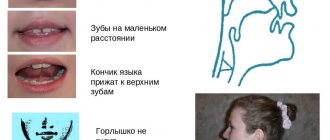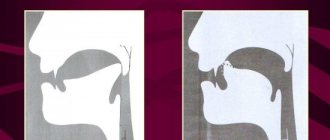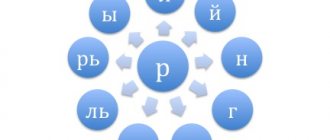Sound automation [C]
- Speech therapist.No
- Automation of sounds
- Automation of sound C
Audio automation exercises [C]. C__ - long pronunciation of the sound [C].
1) Pronounce (read) the syllables S__A, S__O, S__U, S__Y, S__E
The sound [S] is pronounced for a long time
2) Pronounce (read) words with the sound [C] at the beginning
Sample: s-oh
|
|
|
|
3) Pronounce (read) words with the sound [C] in the middle
Sample: kos-a
|
|
|
|
4) Pronounce (read) the syllables AC__, OS__, US__, YS__, ES__, IS__, ES__, YS__, YS__, YS__
The sound [S] is pronounced for a long time
5) Pronounce (read) words with the sound [C] at the end
Sample: us__.
|
|
|
|
6) Pronounce (read) words with a combination of consonants with the sound [C] in the middle
Sample: dis__k.
|
|
|
|
|
7) Pronounce (read) words with a combination of consonants with the sound [C] at the beginning
Sample: с__lon.
|
|
|
|
 Pronounce (read) phrases
Pronounce (read) phrases
- Salted butter.
- Salted cabbage.
- Sweet watermelon.
- Sweet and sour kvass.
- Ripe apricot.
- Radish salad.
- Sausage with garlic.
- Bowl of rice.
- Tall birch tree.
- Dense forests.
- Empty barn.
- Motley dog.
- Old suit.
- Narrow boots.
- Clean dishes.
- Tasty soup.
- Sonya is tired.
- Glory in the bushes.
- Sanya fell asleep.
- Larisa has a stroller.
- Rash the sand, Nastya.
9) Conjugate sentences
- I cut down a pine tree.
- I put the soup on the table.
- I ate a glass of sour cream.
- I broke a branch from a bush.
Sample:
- I slept on the sofa.
- You slept on the sofa.
- He (she) slept on the sofa.
- We slept on the sofa.
- You slept on the sofa.
- They slept on the sofa.
10) Say (read) sentences
Sample: S_they have a smart mind.
- There is a fox in the forest.
- A wasp sits on the sedge.
- There are dishes on the shelf.
- There are tall pines in the forest.
- Stas has blond hair.
- Carry the sand with a shovel.
- Dogs don't bite their own.
- I fell from the sled into the bushes.
- There are staunch soldiers on the desk.
- The ship stopped at a rock.
- The plane flies high above the forest.
- The dog sees an owl on the bitch and barks.
- Sedge dries in the sun.
- Bring dry straw for the donkey.
- There are sweet plums in the garden.
- It's damp outside, put on your boots.
- Sonya, look - catfish!
- The catfish has a mustache.
- In the buffet there is cod, sugar, cheese, lard.
- Sonya brushed the salt off the table.
- Stas eats sausage with garlic.
- The moose broke a pine branch.
- Your kvass is delicious.
- Slava ate the whole pineapple.
- Someone squeaked in the bushes.
11) Pronounce (read) tongue twisters
- Sonya and Sanya have a catfish with a mustache in their nets.
- Haymaking, haymaking, meadow was left without hair.
- A well-fed elephant sleeps peacefully, enjoying its hundredth dream.
- Fall, snow, snow, sprinkle everyone, everyone!
- Elephants are calm and strong.
- I bring soup, soup, and to whom, to the dog, to the dog.
- Little Sanya's sleigh moves on its own.
- Slava ate lard, but there was not enough lard.
- Gander after gander stomp in single file, gander looks down on gander.
- Osa is barefoot and without a belt.
12) Pronounce (read) and retell the text
In the forest
Sanya and Slava were in a pine forest. There was a dog with them. The forest is damp and there is little sun. The dog saw a magpie on the bitch. The magpie saw the dog and flew away. Sanya saw a hedgehog under the pine tree. Sanya failed to catch him. Slava stood up and began to look up. An airplane was flying over the forest. The plane scared the fox. A fox ran past the boys into a hole. Then Sanya and Slava turned home. At the edge of the forest, grass was drying in stacks. The guys rested by the haystack. Soon they were home.
13) Say (read) poems
Sledging
Sanya and Sonya are riding on a sled, pushing the sled. Sleigh jumps, Sanya hits the side, Sonya crashes into a snowdrift.
Ganders
They walk along the line, gander after gander. The gander looks down on the gander. Oh, the Gusak will pluck the gander's sides.
14) Pronounce (read) and memorize a poem
Dream
Sonya, Sanya, the dog and the cat are sleeping peacefully, the catfish with its mustache is falling asleep, the owls are sleeping on the bough.
Lesson 1
Breathing exercises
"Harmonic". I. p. - stand straight, lower your arms. Place your palms on your tummy and take a deep breath through your nose. Hold your breath for 1-2 seconds. Exhale through your mouth. Development of exhalation force. Developing the correct direction of the air stream along the midline of the tongue
"Cold wind". Having drawn air into your lungs, blow forcefully through your lips extended forward with a tube. Bring the back of your hand to your mouth. You should feel a sharp, beating cold stream.
Exercises for lips and facial muscles
Game exercises
"Smile". “We are glad to meet a friend.” Stretch your lips in a smile to the limit and hold them in a tense position for some time. The teeth are closed. Repeat 3-4 times. "Cranky monkeys." Movements with closed lips to the right and left. (If you have difficulty, help with your index fingers.)
Exercises to flatten and strengthen the lateral edges of the tongue
"Track". Place your wide, spread tongue on your lower lip and hold it in this position for a count of 5.
“The tongue is looking for a crack in the fence.” Extending the spread tongue between the teeth and biting it. (Teeth marks should remain on the tongue.)
“The tongue is sleeping on the crib.” Descent of the back of the tongue. Press the tip of the tongue against the lower incisors and lower the back.
Note. In case of difficulty, ask the children to cough and yawn, while the soft palate involuntarily rises and the root of the tongue falls. You can interest children by offering to meet or say hello to the little tongue.
Development of phonemic awareness
Isolation of the sound [s] against the background of syllables and words among sounds that are distant in acoustic and articulatory characteristics.
Game "Catch the Sound". The child should clap his hands when he hears the sound [s]. First, the teacher pronounces the sounds [l], [s], [r] [s], [l], [m], [b], [s], then the syllables la, so, ro, su, pa, su, sy , ba.
If a child identifies a sound from a sound or syllabic series, the words poppy, cheese, souk, shelf, son, bun, lamp, catfish are given.
Development of the voice and switchability of the organs of the articulatory apparatus
Pronunciation of vowel sounds with changes in the strength and pitch of the voice.
“Let’s sing a lullaby to the doll”: a-a-a-a-a-a-a-a-a. “Teeth hurt”: o-o-o “Steam whistle”: o-o-o.
Lesson 3
Breathing exercises
Development of exhalation force
"Put out the candle." Developing an intense intermittent exhalation while pronouncing fuuuuu.
Developing the correct direction of the air stream along the midline of the tongue
"The storm is howling." Bring a bottle with a narrow neck to your lower lip and blow. If noise appears at the same time, it means that the air stream is directed correctly.
Exercises for lips and facial muscles
“The monkey is smiling, and the baby elephant is ready to drink some water.” Lips in a smile (hold for a count of 5-6). Alternating positions - lips in a smile and “tube”. “My teeth hurt on the right side. The teeth on the left side hurt.” Alternately raising the corners of the mouth while simultaneously closing the corresponding eye.
Tongue exercises
"Raindrops are pattering on the roof." Bite your wide tongue with your teeth and pronounce the syllables ta-ta-ta-ta-ta-ta. "Shovel". Place a wide tongue on the lower lip so that the side edges of the tongue touch the corners of the mouth. The language is calm, not tense. If the tongue does not relax, suggest squeezing your lips tightly, then stretch them into a smile and push your tongue between them.
Exercises to develop the ability to form a bow with the lateral edges of the tongue with the upper molars
“The baby learns to pronounce the sound [i].” Place the tip of your tongue behind your lower teeth and pronounce the sound [i]. Make sure that the dimple in the tongue is exactly in the middle. "Donkey's Song" Pronouncing the sound combination ia.
"Boat". Stick your tongue out of your mouth and fold it into a boat (“groove”). If the exercise does not work, you can place a thin stick or probe on the middle part of the tongue. "Fungus". I will collect different mushrooms in a basket - russula, moss mushroom, etc.
Sucking the tongue to the roof of the mouth. (Recommended for use when correcting lateral sigmatism.)
Development of switchability of the organs of the articulatory apparatus and coordinated work of the lips and tongue
Pronouncing the vowels i-yu, yu-ya, i-e, e-ya; i-i-e; and-i-e-yu.
Development of phonemic awareness
Isolating the sound [s] from words. Find toys whose names contain the sound [s], from a number of others (owl, fox, bear, dog, baby elephant, car, giraffe, donkey). Determining the position of the sound [s] in the words owl, baby elephant, forest, nose.
Lesson 5
Development of exhalation force
Developing the correct direction of the air stream along the midline of the tongue. "The wind shakes the leaf." Lips in a smile, teeth open. Blowing on a protruding tongue lying on the lower lip.
Lip exercises
“The hippopotamus has his mouth open, the hippopotamus is asking for rolls.” Smile. On the count of “one,” clench your lips tightly, and on the count of “two,” open your mouth wide.
Tongue exercises
Arching of the back of the tongue upward while the tip rests on the gums of the lower incisors. Pronounce i, hee, ee. Raising and lowering the middle part of the tongue (the back of the tongue with the tip of the tongue lowered at the lower gums. “Boat”. Raise the lateral edges of the tongue until you get a depression in the middle part of the tongue. “Cheerful children.” The starting position is the same. Pronounce sound combinations ihi-hi , ihi-hi, ihi-hi. Development of switchability of the organs of the articulatory apparatus and the development of coordinated work of the lips and tongue “Conversation of aliens.” Pronunciation of the syllables ti-ti-ti, cha-cha-cha, te-te-te (with a change in stress and intonation).Development of phonemic perception and simple types of phonemic analysis - Is there a sound [s] in the words cabbage, beets, radishes, beans, lettuce, garlic? - Find vegetables that have a sound [s] in their names. Where is the sound heard [s] in the word salad? In the word garlic? In the word cabbage?
Development of logical thinking
Game "Fifth Odd". Cabbage, beets, potatoes, radishes, apricots. Set aside the extra picture.
Lesson 1
Automation of the sound [s] in straight syllables Development of articulatory motor skills Repeat the exercises given above: 1) inserting a spread tongue between the teeth; 2) the tongue lies on the “bottom”; 3) tongue “groove”; 4) lips in a smile. Development of memory, attention Memorization and reproduction of syllables in combination with the movement of the fingers. Game tasks “Snowflakes are falling”, “Making snowballs”, “Rolling a snow woman”. Isolation of stressed syllable. Sa-sa; sa-sa; sa-sa-sa; sa-sa-sa; sa-sa-sa. Sy-sy; sy-sy; sy-sy-sy; sy-sy-sy; sy-sy-sy. Sa-sy-so-su; sy-sa-so-su. Which syllable is missing? Sa-sa-sa-sy. Repeat the syllables: sa-sy-so. Listen again. Sa-so. Which syllable disappeared from the series? (So.) So-su-sy-sa. So-su-sy? (Sa.) Analysis and synthesis of syllables - What is the first sound in the syllable sa? What's the second sound? How many sounds are there in the syllable sa? - The sound [s] has become friends with the sound [e]. What syllable did you get? — Is there a sound [s] in the words juice, son, bag, dump truck? Tapping a rhythmic pattern of the words juice, bag, dump truck. Familiarization with the letter c
Lesson 4
Breathing exercises
Development of exhalation force Development of the correct direction of the air stream along the midline “The sled went down the hill.” Smile, lower the tip of your tongue behind your lower teeth, and raise your back up. Exhale. Developing a long, strong exhalation while pronouncing the sound combinations iffffff, iffffff for a long time.
Lip exercises
Lips in a smile (count to 10). "The boat rocks on the waves." Alternately lifting the corners of the mouth up (with and without the help of hands).
Tongue exercises
“The tongue is sick and lies in bed.” Open your mouth wide and cough (the tongue involuntarily drops to the bottom of the mouth). Place the tongue in a “path” on the bottom of the mouth so that a small tongue appears. (Hold in this position for as long as possible.) “Teases.” Place your wide tongue on your lower lip and say: bya-bya-bya-bya-bya, five-five-five-five-five-five (with a change in intonation). The tongue is “grooved” inside the mouth. Note. If the exercise does not work, use a bottle with a narrow neck. When you blow into a bubble, a round gap involuntarily appears in your tongue. "Funny Clowns" Arching of the back of the tongue upward while the tip rests on the gums of the lower incisors. Pronouncing the sound combination i-hee-hee.
Development of switchability of the organs of the articulatory apparatus
“The tongue swings on a swing.” Pronouncing the syllables ya-la, ya-la, ya-la, gradually increasing their number in one exhalation.
Development of phonemic awareness
Distinguishing words that are similar in sound: bear - bowl, helmet - porridge, cheese - ball, salt - naughty (based on pictures). Finding pictures with the sound [s] in their names on the topics “Vegetables” and “Fruits”.
Tips for parents
The speech therapist always gives homework and talks with parents, explaining the importance of the work. After all, the main goal of this stage is to consolidate the correct sound pronunciation in everyday speech. Therefore, parents need not only to follow all the speech therapist’s recommendations, but also to monitor their children’s speech more closely. Correct if the child pronounces a sound incorrectly.
Parents can learn nursery rhymes and short poems with their child - preschool children like rhyming phrases. Be sure to do articulation gymnastics at home to reinforce the correct articulation pattern. Parents should monitor the quality of their speech: pronounce all sounds clearly and correctly.
At the automation stage, they work on correct sound pronunciation, while simultaneously making corrections in other areas. Only through the joint efforts of a speech therapist and parents will the child be able to overcome defects, and his speech will be beautiful and literate.
Features of this stage of speech therapy work
The main tasks of the automation stage are to consolidate correct pronunciation and develop the skill of self-control of speech. This is one of the most labor-intensive stages, the duration of which is difficult to predict. One group of children has difficulty remembering the correct sound image, while others do not experience difficulty with this. To make your work easier, you need to follow certain recommendations:
- select speech material for classes, following the principle - from simple to complex;
- in the first lessons, speech should be as saturated as possible with the sound being practiced without oppositional phonemes;
- if you automate a hard version of a sound, then the speech material should not contain its soft pronunciation;
- first, the speech therapist pronounces the material being worked out, then the child repeats it, then pronounces everything independently;
- during the lesson they use didactic games and visual aids;
- All exercises must be on the same lexical topic.
The speech therapist monitors the purity of sound pronunciation and complicates the tasks only when the child confidently pronounces the phoneme being practiced in the proposed exercises. Before each lesson, the teacher voices the topic and goal, focusing the child’s attention on the lesson.
Lesson 6
Development of exhalation force
Developing the correct direction of the air stream along the midline of the tongue Smile. Lower the tip of your tongue behind your lower teeth, raise your back in a “mound”, and exhale.
Lip exercises
Raising and lowering of the upper lip exposing the upper teeth. Alternate raising and lowering of the corners of the mouth.
Tongue exercises
Keep your tongue motionless with the “groove” on the outside of the mouth, and then open your lips widely, then touch the “groove” with them. Game “I am not me.” The speech therapist pronounces phrases, and the children answer: “And I” or “Not me.” For example, a speech therapist says: “I love chocolate.” And the children answer: “And I, and I, and I.” “I love to chew a cup.” Children: “Not me, not me, not me.” Development of switchability of the organs of the articulatory apparatus and development of coordinated work of the lips and tongue Pronunciation of syllabic combinations pti-pti-pti, pty-pty-pty; petit-pt, petit-pt; pt-pt-pt-pt-pt.
Development of phonemic awareness
“Pick it up and name it.” Place pictures in two piles depicting objects whose names contain the sounds [s] and [w]. Determine the position of the sound [s] in the words sled, boots, owl, bus.
Lesson 2
Breathing exercises
Development of exhalation force
Blowing through a tube. Blowing soap bubbles. Comparison of the duration of exhalation. Pronouncing the sound [f] (long exhalation), pronouncing the sound [t] (short exhalation). Developing the correct direction of the air stream along the midline of the tongue Blow a paper snowflake off your palm. Whose snowflake will fly farther?
Exercises for lips and facial muscles
"We are having fun". "Smile". The lips are in a smile, the teeth are brought together to 2 mm. "Sponges are swinging on a swing." Teeth and lips are clenched. Alternately lift the corners of your mouth with the help of your fingers. “Sleep, little peephole, sleep, other one. The right eye sleeps - wakes up. The left eye sleeps and wakes up.” Alternately opening and closing the eyes.
Tongue exercises
"The tongue is tanning." Place your tongue on the bottom of your mouth. “The tongue dived to the bottom of the river.” "Let's see where the little tongue lives." Lowering the tongue to the bottom of the mouth. “The tongue fits through the crack of the door.” Biting the tongue with teeth from tip to middle and vice versa. "Monkey Teasing" Place your wide tongue on your lower lip and pronounce the syllables five-five-five-five-five.
Development of the voice and switchability of the organs of the articulatory apparatus
"Conversation between the dogs Barbosa and Pushka." Pronouncing syllable combinations pa-ba, py-by, po-bo, pu-bu in a whisper, quietly and loudly.
Development of phonemic awareness
Isolating the sound [s] among sounds that are similar in acoustic and articulatory characteristics. Sounds: [s], [z], [s], [sh], [ts], [s]. Syllables: sa, for, so, sha, tso, su, zy, sy. The words dog, bunny, sun, fur coat, boots, garden, etc. The child raises his hand or claps his hands if he hears the sound [s].









